Whether you want to lift more, look better or simply lessen your aches and pains, you need to work your core. And one of the best moves to build core stability so that you can look, feel and move better is the Basic Plank.
The Basic Plank is one of the best ways to improve your mind-body connection while building core stability so that you can workout harder without injury to reach your health and fitness goals.
However, while the Basic Plank seems like an easy move to do, it is actually very complicated and, when done right, works everything from your shoulders to your knees – not just your abs.
Often when people do Planks, they end up feeling them in their low backs. And rarely do they focus on feeling muscles up and down their core activate and work together to help them hold a nice straight line.
Because if you do a Plank correctly, you shouldn’t feel your low back working, but instead you should feel your shoulders, abs, glutes, quads and adductors all working to hold your body in a nice tight line.
Below are some tips to help you achieve perfect Plank form as well as some fun Plank Variations to use in your warm ups or workouts!
Perfect Plank Form
The perfect plank should look like your body is in a nice straight line from your head to your heels. But it isn’t simply enough to maintain a nice straight line. If you really want to get the most out of the Plank, you need to consciously engage the muscles throughout your core to improve your mind-body connection and make sure everything is working as it should.
At Redefining Strength, we put an emphasis on performing the Pelvic Tilt during our Planks (especially our Front Planks) to make sure our abs are working hard and our low back isn’t. While this may cause your low back to look a bit rounded during the Plank, it ensures that your abs are in fact working.
To do the Basic Forearm Front Plank, lie on your stomach and bend your elbows so that you’re propped up on your forearms. Your legs should be straight out behind you with your feet together. Flex your feet and lift up onto your forearms and toes. Your elbows should be stacked under your shoulders and your feet should be together.

On your forearms and toes, create a nice straight line with your body from your head to your heels. Make sure that in this position you are concentrating on tucking your pelvic to engage your abs as you squeeze your glutes and quads to keep your legs straight. Make sure that you are also squeezing your legs together as you hold and driving back through your heels. Do not push forward onto your toes.
Also, do not let your chest sag toward the ground or your upper back round. You want a nice flat upper back.
While holding, don’t just go through the motions. Assess whether the right muscles are engaged and even consciously activate them. If you begin to shake, you know you are engaging the muscles.
Hold in this position for a set amount of time or until your form starts to break down. If you feel this in your low back, assess whether or not you are performing a proper Pelvic Tilt. For instructions on how to do the Pelvic Tilt, check out this post.
Beginners will want to start with a Plank from their knees or even off an incline to make the move easier.
Basic Plank Variations
The Basic Front Plank can also be done from the hands and toes instead of the forearms (beginners will again want to do this from their knees).

This is a great way to improve your core strength for push ups. Whether or not you do the Plank from your hands or your forearms, you need to engage your entire core and keep your body in a nice straight line.
You can also add in small variations like lifting one foot or stacking your feet to change up the Basic Plank a bit more.
If you want to work your obliques and glute medius and abductors more, you may want to try another variation of the Plank – The Side Plank.
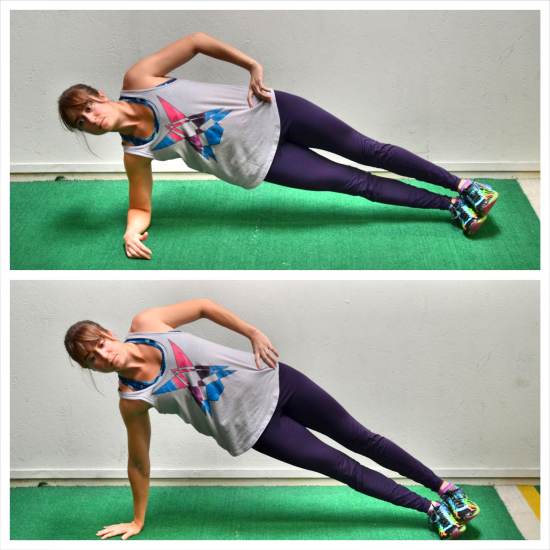
Just like the Basic Front Plank, you can do the Side Plank from your forearm or hand. Doing the Side Plank from your hand is harder and requires more core and shoulder stability. Stacking your feet on top of each other instead of having one foot in front of the other also makes the move harder. Beginners will want to start with a Side Plank from their forearm and knees or knee (you can bend your bottom knee and have your top leg out straight instead of stacking both knees on top of each other).
To do the Basic Side Plank from your forearm, set up on your side and prop yourself up on your forearm with your elbow right below your shoulder. Your legs should be out straight. You can either stack your feet or place your top foot on the ground in front of your bottom foot. Then, driving through your forearm and the sides of your feet, lift your bottom hip up off the ground as high as possible while keeping your body in a nice straight line. Squeeze your belly button in toward your spine and keep your glutes tight. Do not let your chest rotate forward toward the ground or your top hand touch the ground. Keep your top hand on your hip or reach it up toward the ceiling.
Another way to advance the Basic Side Plank and work the glute medius even more is with a leg lift. To do the leg lift, hold the Side Plank and then lift and lower your top leg up and down. Do not let your hips drop toward the ground as you lift the leg.

To make any of the basic plank variations harder, you can add in equipment like the Suspension Trainer or Power Wheel.
You can perform a Front Plank from the Power Wheel with either your hands on the wheel or your feet in the straps. By adding in the wheel, you make the move tougher because the wheel is unstable.
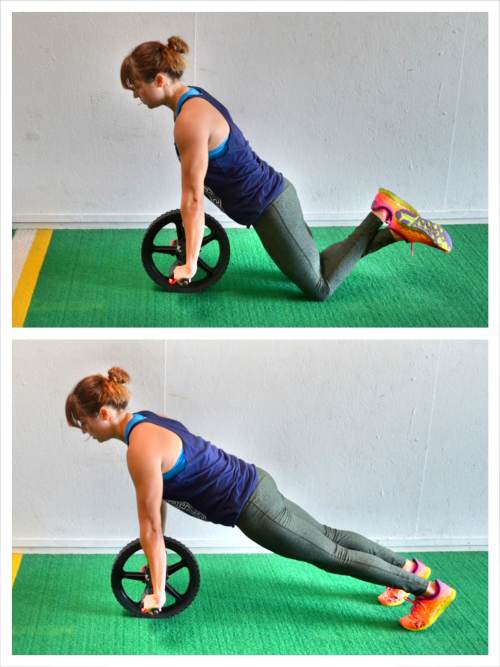
Just like the Power Wheel, the Suspension Trainer can be used to make the Basic Plank Hold harder. It can also be used to make the Side Plank more challenging. To do the Side Plank in the Suspension Trainer, your feet will be in the straps. Doing this move from your forearm will be easier than doing it from your hand. Just like with the Basic Side Plank, you can make the move more challenging by stacking your feet (right) and even adding in the leg lift (bottom left).
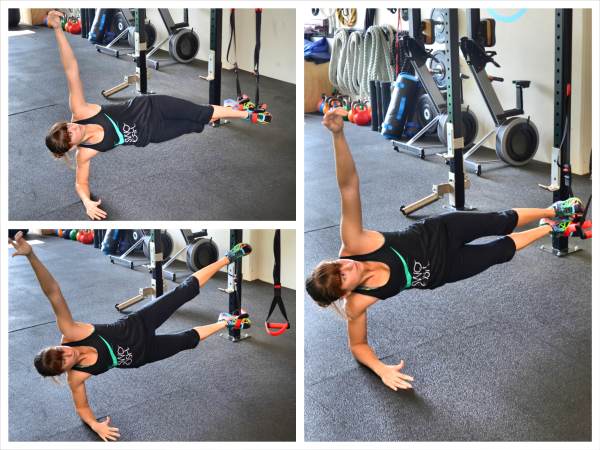
Beginners will not want to add in equipment if they struggle to engage their core when doing the basic moves; however, beginners that can hold a Front Plank from their knees for at least awhile may try a Power Wheel Plank from their knees.
All of these Basic Plank Variations are a great way to improve your core stability. However, they are all isometric movements or holds and it is important to also work on core stability while moving and lifting.
That is why it is important to also include some of these non-isometric Plank Variations in your warm ups and workouts as well.
Plank Variations With Movement
Three great Plank Variations with Movement are the Plank with Reach Back and Out, the Plank with Rotational Reach and the Side Plank with Rotational Reach.
The Plank with Reach Back and Out is a great way to work on hip extension and core stability. It can improve your shoulder stability while also activating your glutes and abs. To do the Plank with Reach Back and Out, set up in a Front Plank from your hands and toes with your hands under your shoulders and your feet about hip-width to shoulder-width apart. For this move, you will want your feet wider to create a more stable base. Beginners can do this move from their knees. Then from the Plank position, reach one hand back and across toward the opposite ankle, pushing your butt back and up toward the ceiling as you reach. Then reach back forward and out toward the wall in front of you, dropping your hips back into a nice plank position. Do not drop your hips too low and feel your low back engage. Keep your core tight to protect your low back as you come back into that nice plank position. Reach back and across with the same hand until all reps are complete on that side.
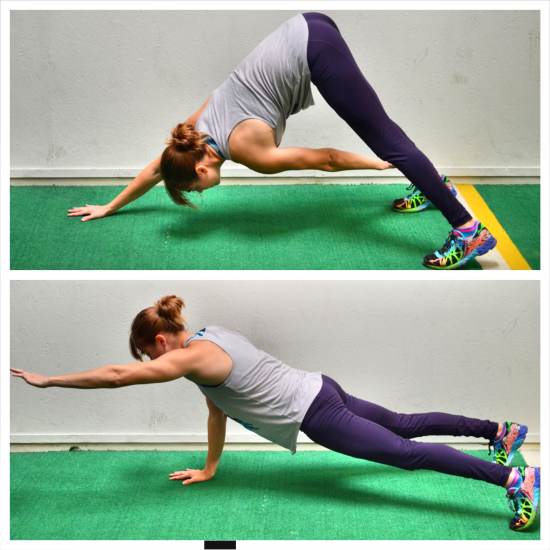
The Plank with Rotational Reach is a great Plank Variation to build rotational strength and core stability. To do this Plank Variation, set up in the high plank position on your hands and knees (beginner) or toes (advanced). Set your feet wider apart to create a more stable base. Then reach one hand under your armpit and toward the far wall. You aren’t just reaching under your armpit to pat yourself on the back. You want to really reach toward the wall. As you reach, make sure your hips stay down. Then pivot open, rotating into a Side Plank as you reach your hand up toward the ceiling. You will reach the hand that reached under your armpit up toward the ceiling, keeping your hips up as you move into a Side Plank. Then reach the hand back down and under your armpit, rotating your hips back down toward the ground and into the Front Plank position. Repeat. Complete all reps on one side before switching and reaching the other way. Do not let your butt go up in the air or your hips sag toward the ground as you reach.

The Plank with Rotational Reach can also be done in the Suspension Trainer (the move in the trainer is almost a hybrid of the Plank and Side Plank with Rotational Reach). However, using the Suspension Trainer makes this move very advanced. Do not add in the trainer until you’ve mastered the movement from the ground.
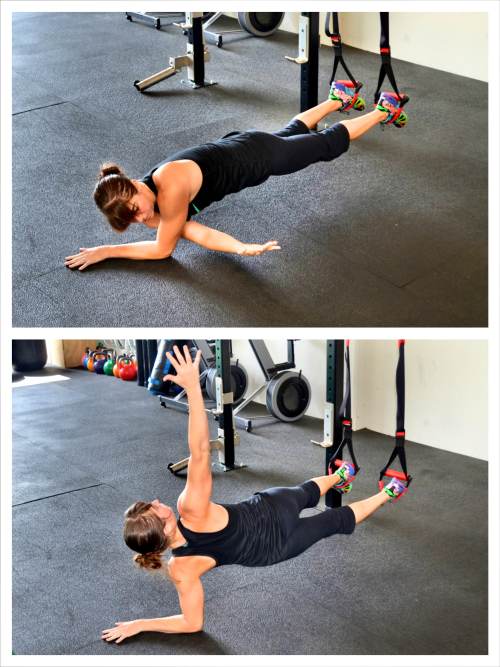
The Side Plank with Rotational Reach is another great rotational Plank. Just like with the Plank with Rotational Reach, you are going to reach under and through and then reach back up toward the ceiling; however, with this variation, you will stay in the side plank position. To do the Side Plank with Rotational Reach, set up in a Side Plank from your forearms and toes (advanced) or forearms and knees (beginner). Reach your top hand under your armpit as if reaching for the wall behind you. Rotate your chest toward the ground as you keep your hips up. Then rotate back open, reaching your hand up toward the ceiling. Do not let your butt go way up in the air as you rotate or your hips drop toward the ground. Repeat, reaching back under and through then up toward the ceiling.
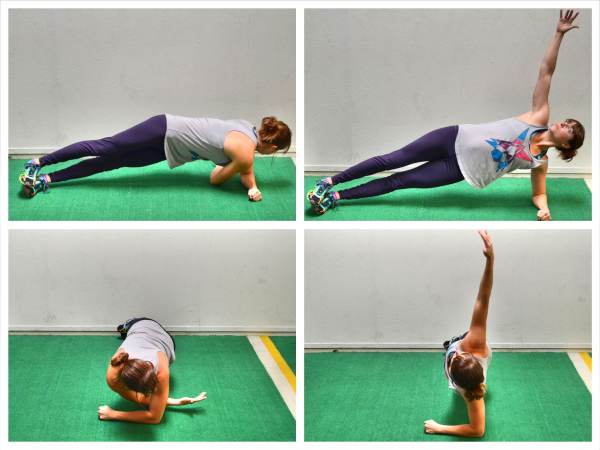
Other Plank Variations
Below are some other great Plank Variations you can include in your workouts. They are all super core intensive and will work your core in different ways than the Basic Plank; however, all of them will build core stability and improve your mind-body connection. The moves below are more advanced bodyweight exercises so only add them if you can keep your core engaged.
The Posterior Plank is a great posterior chain core exercise. This Plank Variation is more focused on working your glutes and back while also stretching out your chest and shoulders. To do the Posterior Plank, sit on the ground with your legs out straight in front of you and your hands down behind your butt on the ground. Then, driving up through your heels and your hands, press your hips up toward the ceiling and press your chest out. Lean your head back as you bridge up. Squeeze your butt and lift your hips up as high as you can while keeping your legs straight and your chest pressed out. Do not shrug your shoulders at the top as you press your chest out. Hold at the top of the move with your body in a nice straight line. Make sure to keep your abs tight so you don’t hyperextend your low back. Consciously squeeze your glutes at the top and draw your shoulder blades down and together. Hold at the top or lower back down and complete reps of the move. If the Posterior Plank is too much, you may want to try the Table Top Bridge.
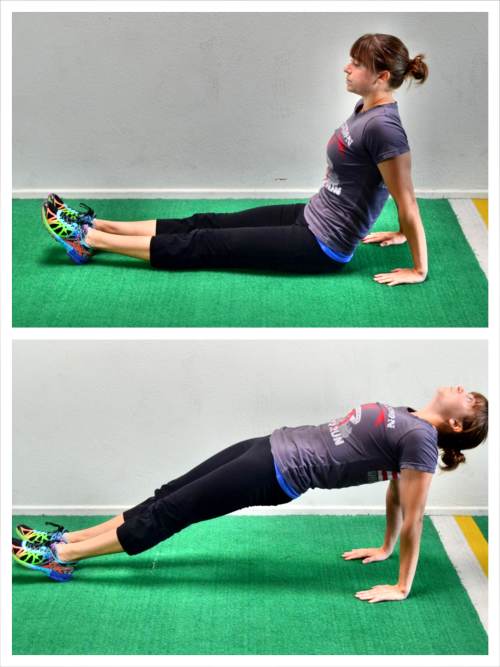
The Lower Ab Plank is another great core stability move. It is also the toughest variation of the Pelvic Tilt so do not attempt this move if you haven’t mastered the other levels of the Pelvic Tilt Progression. The Lower Ab Plank is basically a Double Straight-Leg Lower where you hold your legs out straight an inch or two off the ground instead of lifting and lowering. If your low back comes up off the ground or you start to feel the move in your low back, please regress and do another variation of the Pelvic Tilt Progression. For the complete Pelvic Tilt Progression, click here.
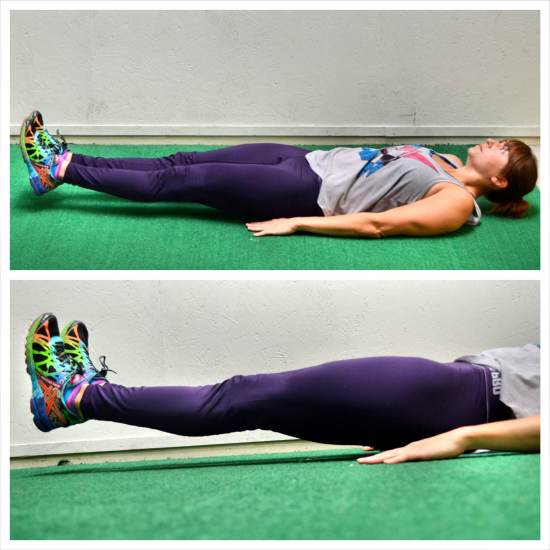
We often forget that the Push Up is basically a moving Plank and that is what makes it so hard. If you want to work on your upper body strength and improve your push ups while building up your core, you may want to try Push Up Holds. You can hold at the top, the middle or the bottom of the push up. Make sure that no matter where you hold, you keep your core engaged and your body in a nice straight line like you do with the Basic Front Plank.

And these Plank Variations are only the beginning. If you have sliders, you can do Planks with Reaches to work your shoulders more.
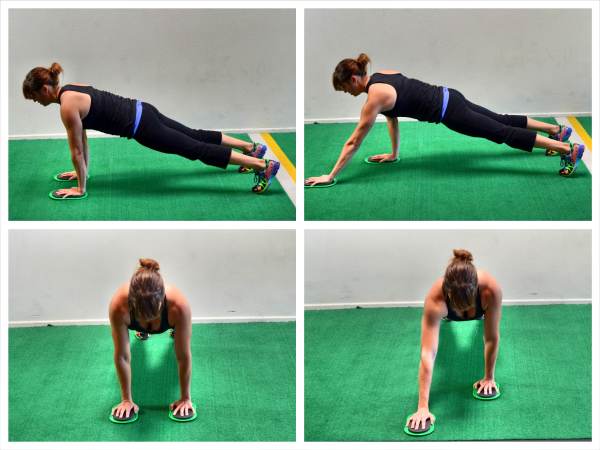
Or you can do Plank Wipers to focus more on your obliques, glute medius and even your adductors.
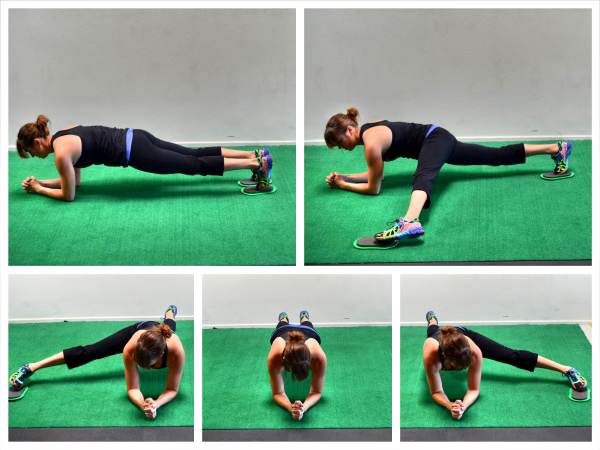
And if you don’t have sliders but have a sandbag, you can do a Plank with Sandbag Pull Through.

But no matter which Plank Variation you choose, remember to engage your core like you do with the Basic Front Plank and Side Plank variations!
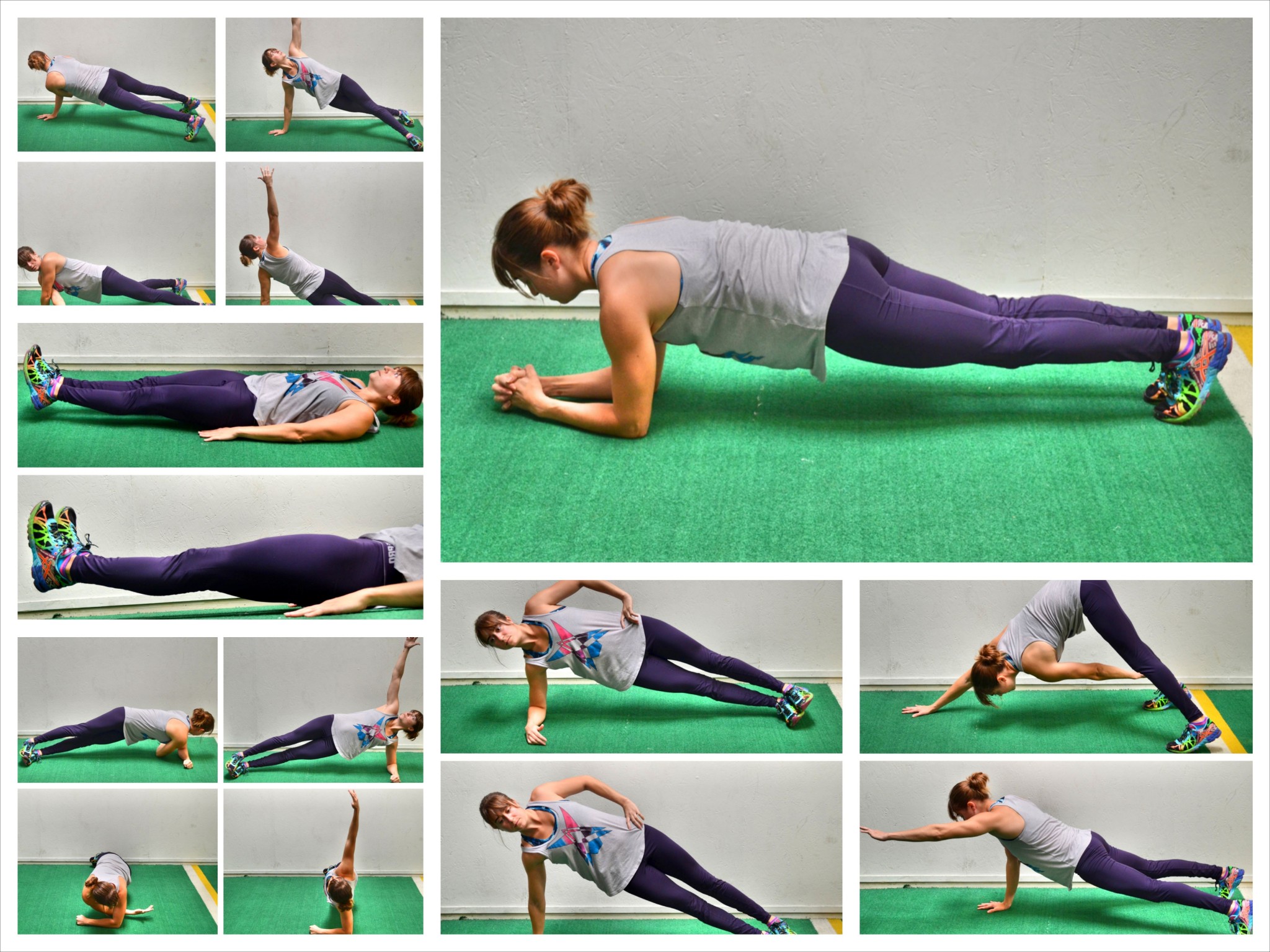
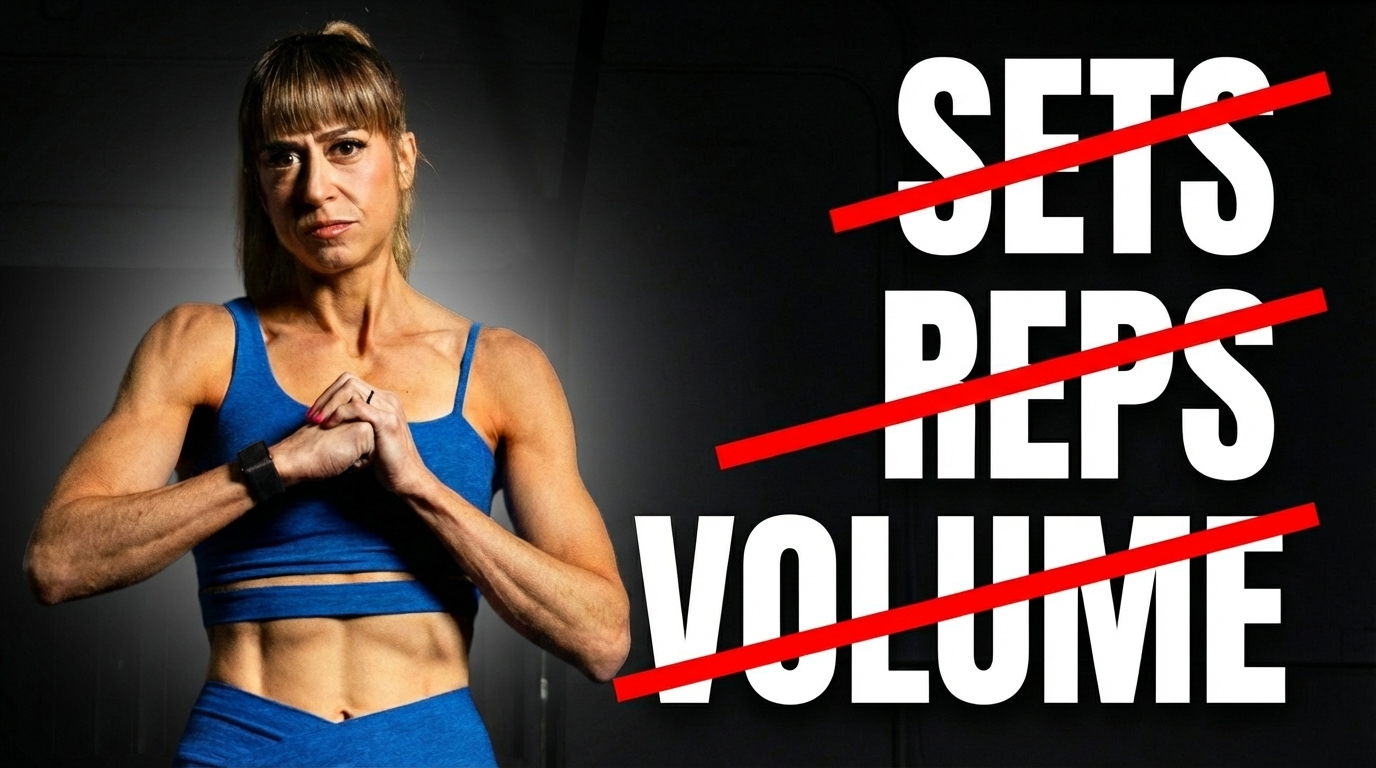

Hi Cori
This info is great. I’ve been having low back pain for a while. It got worse over time, I suspect from doing pushups and situps incorrectly. I’m doing prescribed physio exercises right now,but thought I’d try the way you’ve instructed to do planks. This is nowhere near how I was doing them before! I now don’t feel it in my lower back but I do feel it in my middle back. But not pain – i just feel the muscles being activated. Is this ok or should you not be feeling it there either?
I love all the variety of exercises you have out there!
Thanks:)
Hi Tracy. It’s a start but you want to make sure you’re engaging your lats and not just putting extra load on your thoracic spine. Another couple questions for you. Have you learned the pelvic tilt and are you doing any glute activation as well as foam rolling of your spine? This will be key for mobility and getting all the right muscles working to support your low back. Do you also round or hunch your shoulders? If so some chest foam rolling and thoracic extension work will be key and I mention that because of where you are feeling the planks. – Cori
I can’t seem to get my toes to stay in place?
Like they slide back? Drive back through the balls of your feet to flex your quads.
I don’t think you have the proper lower arms when you do the low plank, you should have your arms parallel not bracing your palms together…
It’s not “right” or “wrong.” There is a different purpose to each position. With hands parallel and palms flat, you can engage your pecs more pressing down into the ground, which can help with anterior chain engagement. This is great if you are especially using planks to build up your push ups. However, if you tend to already have tight pecs and struggle with shoulder issues, I find hands together with elbows slightly out, can help with better lat activation to avoid overloading your shoulders or shrugging.